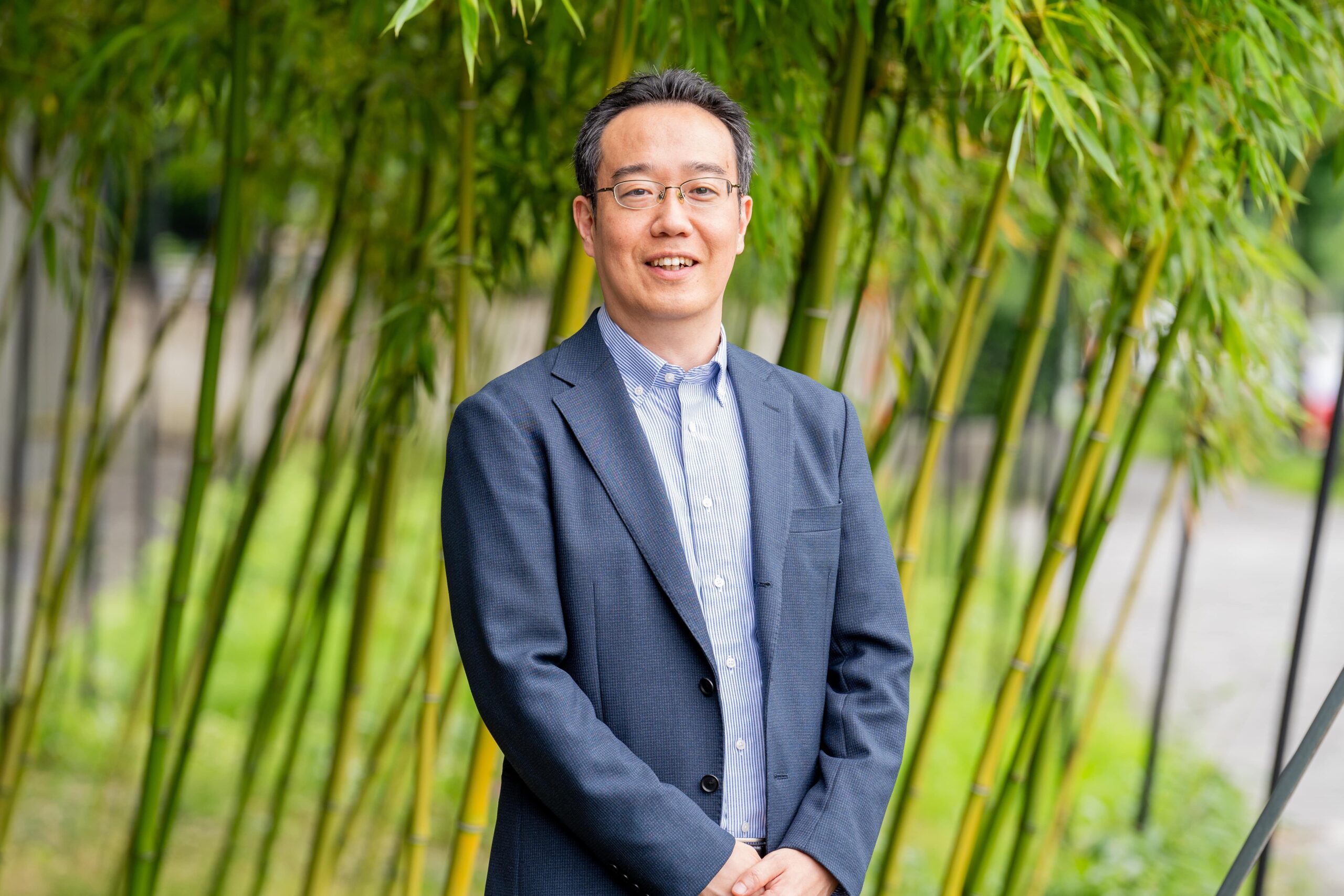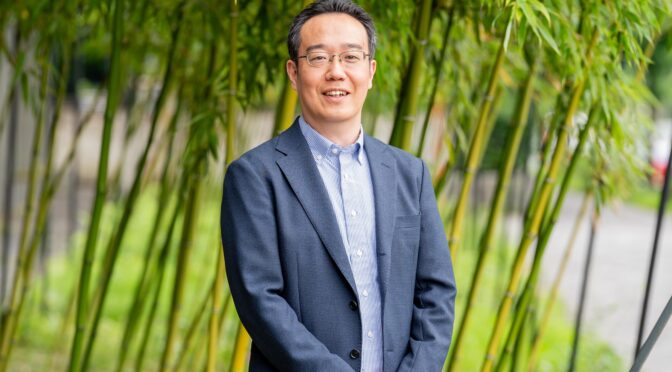- HOME
- >
- PROJECT
- >
- Researcher Profile
- >
- Reframing Our View of Humanity Through an Interdisciplinary Understanding of Human Behavior (Professor Nobuhito Abe)
Reframing Our View of Humanity Through an Interdisciplinary Understanding of Human Behavior (Professor Nobuhito Abe)
2025.07.16
(Interview and text by Shinko Enjo)

Going Back-and-Forth Between the Natural Sciences and the Humanities
I am currently engaged in research in cognitive neuroscience, but my academic path wasn’t so straightforward. In high school, I was enrolled in a science-focused track, but when it came time to choose a university I had developed an interest in Chinese history—especially the 14th-century historical novel Romance of the Three Kingdoms. This led me to the Department of Oriental History in the Faculty of Arts and Letters at Tohoku University. Chinese history research, of course, was completely different from what I’m doing now—entirely contained within the domain of the humanities. And even though the meticulous process of reading and deciphering classical Chinese texts in their original forms was interesting, I felt a little bit unsure about dedicating my life to this work.
While I was spending my university years with such thoughts, I encountered an opportunity to participate in an experiment that involved measuring brain activity—an entirely unfamiliar field to me. Around the turn of the 21st century, advances in technology had made it increasingly possible to measure brain activity in living humans, something that previously had been considered extremely difficult. I had always been interested in psychology, and the ability to visualize brain activity left a profound impression on me. Afterwards, I spoke with the associate professor in charge of the experiment about my interest in studies focused on humans and the mind, and eventually enrolled in the Graduate School of Medicine at Tohoku University. In a way, I returned to the sciences from the humanities.
I joined a laboratory specializing in higher brain dysfunction, where many members were researchers focusing on brain disorders. They studied what specific brain regions, when damaged, would cause the loss of which abilities: There were patients who, for example, had a clear memory but suffered from aphasia, or could speak but had poor spatial awareness. There were various kinds of cases, and they studied the relation between the damaged areas in their brains and their cognitive impairments. While many researchers at the laboratory focused on such clinical cases, there were also others who conducted experiments measuring brain activity in healthy individuals—for example, to investigate how the brain functions during arithmetic or language comprehension. Altogether, I spent about seven years at the laboratory, first as a graduate student and then as an assistant professor, conducting research involving both brain-damaged patients and healthy individuals.
After that, from April 2010 to March 2012, I continued my research for two years at the Department of Psychology at Harvard University. The professor at my lab originally came from a philosophy background. He focused on tackling ethical dilemmas—such as whether it is right to sacrifice one person to save five—not only through philosophical reasoning, but also by integrating methods from the natural sciences, viewing these decisions as mechanisms of moral judgment in the brain. Although his methods aligned with psychology and neuroscience, he firmly identified as a philosopher. His approach exemplified interdisciplinary research: It approached issues rooted in the humanities and social sciences—such as philosophical inquiries—not solely with humanities-based methods, but by incorporating scientific approaches. And when interpreting the results, it returned to the humanities and social sciences, reexamining the findings through accumulated knowledge in the humanities and philosophical reflection.
Simply attempting to blend the humanities and sciences can often lead to confusion, so it is essential to carefully consider how to make use of the strengths of each discipline. It was through this experience of moving back and forth between the two domains that I found my way to what is now the Institute for the Future of Human Society (then known as the Kokoro Research Center) at Kyoto University in April 2012.
Decision-Making as the Interplay of Diverse Parameters
My current research focuses on the mechanisms behind human decision-making and moral judgment, particularly honesty and dishonesty. But honesty and dishonesty come in many forms, and I often use everyday situations as examples to illustrate this: Imagine you go to a convenience store, buy a snack, and pay with a 1,000-yen bill. The correct change should be 630 yen, but the cashier accidentally gives you 730 yen. You are supposed to give 100 yen back, and in this situation, some people walk away despite knowing they should return the extra 100 yen. Others may not care and just pocket the money. Some may return it without hesitation, while others struggle internally but ultimately decide to do the right thing. My basic motivation is to explain these behaviors scientifically by uncovering the brain mechanisms behind them.
To simply say that these behaviors are a matter of personality or “case-by-case” differences isn’t quite scientific. What I aim to uncover are the factors that cause such individual differences. For example, there is a region in the brain (called the nucleus accumbens) that gets activated through a neurotransmitter called dopamine. This area is in charge of the excited feelings we get when there are anticipated rewards—like delicious food or payday—and the pleasure associated with obtaining such rewards. When we gain a reward, this brain area motivates us to try to obtain it again the next time a similar opportunity arises. However, this brain region functions differently from person to person, and individuals with higher nucleus accumbens activity have been found to be more likely to lie in tasks where deception can lead to financial gain.
I also try to incorporate philosophical perspectives into interpreting the findings of my work, such as the debate of whether human nature is inherently bad or good: For example, if a person has high activity in the nucleus accumbens, they are more likely to impulsively go for a reward, which makes lying feel like a natural choice – fitting well with the notion that humans are inherently evil. On the other hand, if someone has low activity in the nucleus accumbens, they’re less tempted to jump at the reward and can more easily return the extra change—aligning with the belief that humans are inherently good. This suggests that the relationship between these two views—humans as inherently good vs. inherently bad—can be understood as a gradient rather than a binary, by looking into nucleus accumbens. It’s not about one theory being right and the other wrong; rather, by focusing on certain parameters, we can propose a framework that accommodates both perspectives. Of course, reward sensitivity isn’t the only factor—many parameters are involved, and I believe that human decision-making ultimately results from a combination of diverse parameters. As we accumulate more findings, I think that we may gradually come closer to understanding the true nature of human character and decision-making with greater scientific clarity.
Lately, I’ve also begun studying dishonesty that hides behind seemingly moral actions and justifications. Take, for example, cases of inspection fraud at automobile manufacturers. These aren’t always driven by personal greed, instead it is possible for individuals to believe that by staying silent about these wrongdoings they are protecting their team from facing troubles. When people believe that they are lying for others, it becomes easier to morally justify their behavior, allowing them to do bad deeds without guilt. I want to explore these kinds of phenomena more scientifically.
Gambling addiction is also, in a broad sense, a form of decision-making problem. In recent years, I’ve worked with companies to analyze customer data from casinos: For example, in games like baccarat, we analyze when customers place bets, how much they bet, how much they win or lose, what kinds of behaviors are risky, and what leads them to become deeply absorbed. We analyze data from thousands to tens of thousands of customers this way. In one recent news story, a woman stole a billion yen from a bank vault and lost it through speculative trading. This kind of investment behavior can be seen as a form of gambling addiction. Many embezzlement cases follow a similar path: they start small, and then escalate as the person becomes desensitized. That’s why believe that research on the mechanisms of unethical behavior and research on gambling have overlapping areas, and I feel it’s important to study them in an integrated way.
Scientifically Understanding Human Behavior and Fostering It Around the World
With the advancement of technologies like robots and AI, new challenges are emerging, such as what should we do if an AI lies to us. Ultimately, this comes down to whether and how humans can control the behavior of such systems, and insights from our research on the mechanisms of lying may contribute to this timely discussion. It’s also important to note that lies aren’t always bad. In some cases, they serve as social lubricants, but not everyone finds it easy to tell such “white lies.” For instance, someone might struggle to tell a friend that the dish they made tastes good when it is not, even if this white lie may be born out of consideration for the other. They may genuinely believe they’re doing the right thing by being honest yet find themselves not doing a good job in relationships with others, and that can be quite distressing. Of course, I’m not saying that telling the truth is wrong, nor am I suggesting that people should be encouraged to lie. What I do want to say is that if we want to properly understand such individual differences, we need to explore the underlying mechanisms through a scientific approach.
At the core, I hope to contribute to updating our understanding of human nature by expanding the methods, frameworks, and tools we use to understand people more accurately.. Take Freud, for example: he proposed the concept of the “unconscious”—a deep layer of the mind that we are not aware of. Even today, we may see a drunken person who lashes out and say: “That must be their unconscious talking.” Whether or not that interpretation is correct, the fact that we can even think this way reflects how the concept of the unconscious has been cultivated and accepted globally. Of course, future research may drastically change our ways of thinking. But at the very least, I believe that the concept of the unconscious has elevated our ability to understand human beings by one step.
There are still many aspects of human behavior that remain difficult to understand. How do we interpret it when someone with a long history of criminal behavior suddenly shows kindness? Or when a seemingly upright person steals from a bank? With our current methods of understanding human nature, we often struggle to explain such contradictions. We sometimes may end up saying vague things like, “Humans are just unpredictable,” and leave it at that. But instead of settling for ambiguity, I hope that my work can introduce even one or two new and scientifically grounded concepts which, while perhaps not as universally prevalent as Freud’s unconscious, can still bring us closer to a more scientific understanding of human behavior, and shape the ways that we view human nature in the future.


